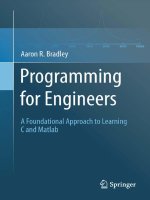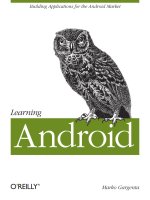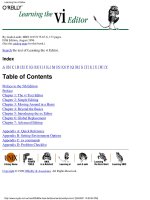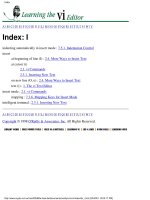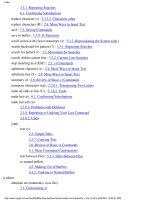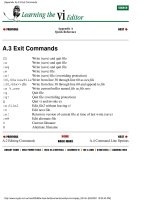2002 oreilly learning c sharp1
Bạn đang xem bản rút gọn của tài liệu. Xem và tải ngay bản đầy đủ của tài liệu tại đây (3.39 MB, 808 trang )
Tableof
•
Contents
• Index
• Reviews
Reader
•
Reviews
• Errata
LearningC#
ByJesseLiberty
Publisher :O'Reilly
PubDate :September2002
ISBN :0-596-00376-5
Pages :368
Slots :1
WithLearningC#,best-sellingauthorJesseLibertywill
helpyoubuildasolidfoundationin.NETandshowhowto
applyyourskillsbyusingdozensoftestedexamples.You
willlearnhowtodevelopvariouskindsofapplications-includingthosethatworkwithdatabases--andweb
services.Whetheryouhavealittleobject-oriented
programmingexperienceoryouarenewtoprogramming
altogether,LearningC#willsetyoufirmlyonyourway.
LearningC#
ByJesseLiberty
Tableof Publisher :O'Reilly
•
Contents PubDate :September2002
ISBN :0-596-00376-5
• Index
Pages :368
• Reviews
Slots :1
Reader
•
Reviews
• Errata
Copyright
Preface
AboutThisBook
WhoThisBookIsFor
HowtheBookIsOrganized
ConventionsUsedinThisBook
Support
We'dLiketoHearfromYou
Acknowledgments
Chapter1.C#and.NETProgramming
Section1.1.C#and.NET
Section1.2.The.NETPlatform
Section1.3.The.NETFramework
Section1.4.TheC#Language
Section1.5.TheStructureofC#Applications
Section1.6.TheDevelopmentEnvironment
Chapter2.GettingStartedwithC#
Section2.1.What'sinaProgram?
Section2.2.YourFirstProgram:HelloWorld
Section2.3.ExaminingYourFirstProgram
Chapter3.Object-OrientedProgramming
Section3.1.CreatingModels
Section3.2.ClassesandObjects
Section3.3.DefiningaClass
Section3.4.ClassRelationships
Section3.5.TheThreePillarsofObject-OrientedProgramming
Section3.6.Encapsulation
Section3.7.Specialization
Section3.8.Polymorphism
Section3.9.Object-OrientedAnalysisandDesign
Chapter4.VisualStudio.NET
Section4.1.StartPage
Section4.2.InsidetheIntegratedDevelopmentEnvironment(IDE)
Section4.3.IntelliSense
Section4.4.BuildingandRunning
Section4.5.ForMoreInformation
Chapter5.C#LanguageFundamentals
Section5.1.Types
Section5.2.Variables
Section5.3.DefiniteAssignment
Section5.4.Constants
Section5.5.Strings
Section5.6.Statements
Section5.7.Expressions
Section5.8.Whitespace
Chapter6.Branching
Section6.1.UnconditionalBranchingStatements
Section6.2.ConditionalBranchingStatements
Section6.3.Iteration(Looping)Statements
Chapter7.Operators
Section7.1.TheAssignmentOperator(=)
Section7.2.MathematicalOperators
Section7.3.IncrementandDecrementOperators
Section7.4.RelationalOperators
Chapter8.ClassesandObjects
Section8.1.DefiningClasses
Section8.2.MethodArguments
Section8.3.Constructors
Section8.4.Initializers
Section8.5.CopyConstructors
Section8.6.ThethisKeyword
Section8.7.StaticandInstanceMembers
Section8.8.DestroyingObjects
Chapter9.InsideMethods
Section9.1.OverloadingMethods
Section9.2.EncapsulatingDatawithProperties
Section9.3.ReturningMultipleValues
Chapter10.BasicDebugging
Section10.1.SettingaBreakpoint
Section10.2.TheCallStack
Chapter11.InheritanceandPolymorphism
Section11.1.SpecializationandGeneralization
Section11.2.Inheritance
Section11.3.Polymorphism
Section11.4.AbstractClasses
Section11.5.SealedClasses
Section11.6.TheRootofAllClasses:Object
Section11.7.BoxingandUnboxingTypes
Chapter12.OperatorOverloading
Section12.1.UsingtheoperatorKeyword
Section12.2.CreatingUsefulOperators
Section12.3.LogicalPairs
Section12.4.ConversionOperators
Chapter13.Structs
Section13.1.DefiningaStruct
Chapter14.Interfaces
Section14.1.ImplementinganInterface
Section14.2.ImplementingMoreThanOneInterface
Section14.3.CastingtoanInterface
Section14.4.ExtendingInterfaces
Section14.5.CombiningInterfaces
Section14.6.OverridingInterfaceImplementations
Section14.7.ExplicitInterfaceImplementation
Chapter15.Arrays
Section15.1.Arrays
Section15.2.MultidimensionalArrays
Section15.3.System.Array
Section15.4.Indexers
Chapter16.CollectionInterfacesandTypes
Section16.1.TheCollectionInterfaces
Section16.2.ArrayLists
Section16.3.Queues
Section16.4.Stacks
Section16.5.CopyingfromaCollectionTypetoanArray
Chapter17.Strings
Section17.1.CreatingStrings
Section17.2.ManipulatingStrings
Section17.3.RegularExpressions
Section17.4.TheRegexClass
Chapter18.ThrowingandCatchingExceptions
Section18.1.ThrowingExceptions
Section18.2.SearchingforanExceptionHandler
Section18.3.ThethrowStatement
Section18.4.ThetryandcatchStatements
Section18.5.HowtheCallStackWorks
Section18.6.CreatingDedicatedcatchStatements
Section18.7.ThefinallyStatement
Section18.8.ExceptionClassMethodsandProperties
Section18.9.CustomExceptions
Chapter19.DelegatesandEvents
Section19.1.Delegates
Section19.2.Multicasting
Section19.3.Events
Afterword
WheretoGofromHere
AdvancedTopicsinC#
Web(ASP.NET)Programming
WindowsFormsProgramming
OtherResources
C#Keywords
A
B
C
D
E
F
G
I
L
N
O
P
R
S
T
U
V
W
Colophon
Index
Copyright©2002O'Reilly&Associates,Inc.Allrightsreserved.
PrintedintheUnitedStatesofAmerica.
PublishedbyO'Reilly&Associates,Inc.,1005GravensteinHighway
North,Sebastopol,CA95472.
O'Reilly&Associatesbooksmaybepurchasedforeducational,
business,orsalespromotionaluse.Onlineeditionsarealsoavailablefor
mosttitles().Formoreinformationcontactour
corporate/institutionalsalesdepartment:800-998-9938or
NutshellHandbook,theNutshellHandbooklogo,andtheO'Reillylogo
areregisteredtrademarksofO'Reilly&Associates,Inc.Manyofthe
designationsusedbymanufacturersandsellerstodistinguishtheir
productsareclaimedastrademarks.Wherethosedesignationsappearin
thisbook,andO'Reilly&Associates,Inc.wasawareofatrademark
claim,thedesignationshavebeenprintedincapsorinitialcaps.The
associationbetweentheimageofagoldfishandthetopicofLearningC#
isatrademarkofO'Reilly&Associates,Inc.
Whileeveryprecautionhasbeentakeninthepreparationofthisbook,
thepublisherandtheauthorassumenoresponsibilityforerrorsor
omissions,orfordamagesresultingfromtheuseoftheinformation
containedherein.
Preface
InJuly2000,Microsoftannouncedthereleaseofitsnew.NETplatform,
whichrepresentedamajorchangeinthewaypeoplethinkabout
programming..NETfacilitatesobject-orientedInternetdevelopment.C#
isaprogramminglanguagethatwasdevelopedspecificallyforthe
purposeofwritingapplicationsforthe.NETplatform.C#buildson
lessonslearnedfromotherlanguages,likeC(highperformance),Java
(highsecurity),andVisualBasic(rapiddevelopment).Andthisnew
languageisideallysuitedfordevelopingdistributedwebapplications.
AboutThisBook
LearningC#isaprimerontheC#language,inthecontextofthe.NET
developmentenvironment,andalsoonobject-orientedprogramming.
ThisbookfocusesonthefundamentalsoftheC#programming
language,bothsyntacticalandsemantic.Aftermasteringtheseconcepts,
youshouldbereadytomoveontoamoreadvancedprogrammingguide
thatwillhelpyoucreatelarge-scalewebandWindowsapplications.
Afterword,providesanumberofsuggestionsforyourcontinuedstudyof
C#and.NETdevelopment.
WhoThisBookIsFor
LearningC#waswrittenforprogrammerswithlittleornoobject-oriented
programmingexperience,aswellasfornoviceprogrammers.Those
comingfromanotherlanguagemayhaveaslightadvantage,butI've
triedtoprovideanon-rampforbeginnersaswell,bydefiningallterms,
demonstratingtherelationshipsamongthevariousconstructs,and
reviewingkeyconceptsalongtheway.
HowtheBookIsOrganized
Chapter1,introducesyoutotheC#languageandthe.NETplatform.
Chapter2,presentsasimpleapplicationthatprintsthewords"Hello
World"toaconsolewindow,andgivesaline-by-lineanalysisofthecode.
Chapter3,explainstheprinciplesbehindandgoalsofthisprogramming
methodology,includingthethreepillarsofobject-orientedprogramming:
encapsulation,specialization,andpolymorphism.
Chapter4,introducestheIntegratedDevelopmentEnvironment(IDE)
designedspecificallyfor.NET;usingtheIDEcangreatlysimplifyhowyou
writeapplications.
Chapter5,introducesthebasicsyntaxandstructureoftheC#language,
includingtheintrinsictypes,variables,statements,andexpressions.
Chapter6,describessomeofthewaysyoucanchangetheorderin
whichmethodsarecalledwithinaprogram.Statementssuchasif,
switch,goto,andbreakwillbeconsidered,alongwiththeconceptof
loops,whicharecreatedusingsuchkeywordsasfor,while,and
do...while.
Chapter7,describessomeofthesymbolsthatcauseC#totakean
action,suchasassigningavaluetoavariableandarithmetically
operatingonvalues(adding,subtracting,andsoforth).
Chapter8,introducesthekeyconceptsofprogrammer-definedtypes
(classes)andinstancesofthosetypes(objects).Classesandobjectsare
thebuildingblocksofobject-orientedprogramming.
Chapter9,delvesintothespecificprogramminginstructionsyou'llwrite
todefinethebehaviorofobjects.
Chapter10,introducesthedebuggerintegratedintotheVisualStudio
.NETIntegratedDevelopmentEnvironment.
Chapter11,explorestwoofthekeyconceptsbehindobject-oriented
programminganddemonstrateshowyoumightimplementtheminyour
code.
Chapter12,explainshowtoaddstandardoperatorstothetypesyou
define.
Chapter13,introducesthestructureorstruct,aprogrammer-definedtype
similartoaclass,butwithspecificandmorelimitedfunctionality.
Chapter14,explainshowyoucandefineasetofbehaviors(aninterface)
thatanynumberofclassesmightimplement.
Chapter15,introducesthearray,anindexedcollectionofobjectsthatare
allthesametype.Arraysareoneofthecollectiontypesrecognizedby
C#.
Chapter16,describessomeoftheotherC#collections,includingstacks
andqueues.
Chapter17,discussesthemanipulationofstringsofcharacters,theC#
stringclass,andregularexpressionsyntax.
Chapter18,explainshowtohandleerrorsandabnormalconditionsthat
mayariseinrelationtoyourprograms.
Chapter19,discusseshowtowritecodetorespondtoprogramming
occurrenceslikemouseclicks,keystrokes,andotherevents;event
handlingisoftenaccomplishedbytheuseofdelegates,whichare
objectsthatencapsulateanymethodthatmatchesthedelegate's
specification.
Afterword,describeswhereyoumightgotolearnmoreaboutC#and
.NETprogramming,includingotherbooks,websites,newsgroups,and
soforth.
ThebookconcludeswithanappendixofC#Keywords.
ConventionsUsedinThisBook
Thefollowingfontconventionsareusedinthisbook:
Italic
Usedforpathnames,filenames,programnames,Internetaddresses,
suchasdomainnamesandURLs,andnewtermswheretheyare
defined.
ConstantWidth
Usedforcommandlinesandoptionsthatshouldbetypedverbatim,
C#keywords,andcodeexamples.
ConstantWidthItalic
Usedforreplaceableitems,suchasvariablesoroptionalelements,
withinsyntaxlinesorcode.
ConstantWidthBold
Usedforemphasiswithinprogramcode.
Payspecialattentiontonotessetapartfromthetextwiththefollowing
icons:
Thisisatip.Itcontainsusefulsupplementaryinformationabout
thetopicathand.
Thisisawarning.Ithelpsyousolveandavoidannoying
problems.
Support
Aspartofmyresponsibilitiesasauthor,Iprovideongoingsupportformy
booksthroughmywebsite:
Onthiswebsite,you'llalsofindthesourcecodeforalltheexamplesin
LearningC#,aswellasaccesstoabook-supportdiscussiongroupwitha
sectionsetasideforquestionsaboutC#.Beforeyoupostaquestion,
however,pleasechecktheFAQ(FrequentlyAskedQuestions)listand
theerratafileonmywebsite.Ifyoucheckthesefilesandstillhavea
question,thenpleasegoaheadandposttothediscussioncenter.
Themosteffectivewaytogethelpistoaskaveryprecisequestionor
eventocreateaverysmallprogramthatillustratesyourareaofconcern
orconfusion.Youmayalsowanttocheckthevariousnewsgroupsand
discussioncentersontheInternet.Microsoftoffersawidearrayof
newsgroups,andDevelopmentor()has
wonderful.NETemaildiscussionlist,asdoesCharlesCarrollat
.
We'dLiketoHearfromYou
Wehavetestedandverifiedtheinformationinthisbooktothebestofour
ability,butyoumayfindthatfeatureshavechanged(oreventhatwe
havemademistakes!).Pleaseletusknowaboutanyerrorsyoufind,as
wellasyoursuggestionsforfutureeditions,bywritingto:
O'Reilly&Associates,Inc.
1005GravensteinHighwayNorth
Sebastopol,CA95472
(800)998-9938(intheU.S.orCanada)
(707)829-0515(international/local)
(707)829-0104(fax)
Wehaveawebpageforthisbookwherewelistexamplesandanyplans
forfutureeditions.Youcanaccessthisinformationat:
/>Youcanalsosendmessageselectronically.Tobeputonthemailinglist
orrequestacatalog,sendemailto:
Tocommentonthebook,sendemailto:
Formoreinformationaboutthisbookandothers,aswellasadditional
technicalarticlesanddiscussionontheC#andthe.NETFramework,see
theO'Reilly&Associateswebsite:
andtheO'Reilly.NETDevCenter:
/>
ONDotnet.comprovidesindependentcoverageoffundamental,
interoperable,andemergingMicrosoft.NETprogrammingandWeb
servicestechnologies.
Acknowledgments
ToensurethatLearningC#isaccurate,complete,andtargetedatthe
needsandinterestsofprogrammers,Ienlistedthehelpofsomeofthe
brightestpeopleIknow,includingDanHurwitz,SethWeiss,andSue
Lynch.
JohnOsbornsignedmetoO'Reilly,forwhichIwillforeverbeinhisdebt.
ClaireCloutierandTatianaDiazhelpedmakethisbookbetterthanwhat
I'dwritten.RobRomanocreatedanumberoftheillustrationsand
improvedtheothers.TimO'Reillyprovidedsupportandresources,and
I'mgrateful.AspecialthankyoutoValQuercia,whoaddedgreatvalueto
thisbook,asshehastomanyothers.Ifthisbookisclearand
understandable,itisduetohervigilance.
Chapter1.C#and.NETProgramming
LearningC#introducesC#specifically,andthe.NETdevelopment
platformmoregenerally,toprogrammerswithlittleornoobject-oriented
programmingexperience.Alongtheway,youwilllearnagreatdealabout
writinghigh-quality,industrial-strengthprogramsfor.NET.
ThisbriefintroductionwillshowyouhowC#fitsintothe.NETpicture,
whatyoucandowiththelanguage,andwhatbenefitsthislanguagehas
overitspredecessors.
Youwillalsolearnsomeoftheconceptsintegraltoobject-oriented
programming,whichhasrevolutionizedhowwebandWindows
applicationsaredeveloped.Object-orientedprogrammingiscloselytied
tothesemanticsoftheC#language,thatis,themeaningbehindthe
codeyouwrite.Obviously,youneedtohaveabasicunderstandingofthe
syntaxoftheC#language,butyoualsoneedtounderstandwhatyouare
actuallytryingtoaccomplish.
1.1C#and.NET
Inthepast,youmighthavelearnedalanguagelikeCorJavawithout
muchconcernabouttheplatformonwhichyouwouldbeprogramming.
Thesecross-platformlanguageswereascomfortableonaUnixboxas
theywereonaPCrunningWindows.
C#,however,wascreatedspecificallyfor.NET.While.NETmaybecome
cross-platformsomedaysoonaUnixportisreportedlyintheoffingfor
nowtheoverwhelmingmajorityof.NETprogramswillbewrittentorunon
amachinerunning.NET.Atthetimeofthiswriting,thatmeansa
Windowsmachine.
1.2The.NETPlatform
WhenMicrosoftannouncedC#inJuly2000,itsunveilingwaspartofa
muchlargerevent:theannouncementofthe.NETplatform.The.NET
platformisadevelopmentframeworkthatprovidesanewwaytocreate
Windowsapplications.However,.NETgoesbeyondtraditionalWindows
programmingtofacilitatecreatingwebapplicationsquicklyandeasily.
Microsoftsaysitisdevoting80%ofitsresearchanddevelopmentbudget
to.NETanditsassociatedtechnologies.Theresultsofthiscommitment
areimpressive.Foronething,thescopeof.NETishuge.Theplatform
consistsofthreeseparateproductgroups:
Asetoflanguages,includingC#andVisualBasic.NET;asetof
developmenttools,includingVisualStudio.NET;andpowerfultools
forbuildingapplications,includingtheCommonLanguageRuntime
(CLR),aplatformforcompiling,debugging,andexecuting.NET
applications.
Asetof.NETEnterpriseServers,formerlyknownasSQLServer
2000,Exchange2000,BizTalk2000,andsoon,thatprovide
specializedfunctionalityforrelationaldatastorage,email,B2B
commerce,etc.
New.NET-enablednon-PCdevices,fromcellphonestogame
boxes.
TheC#languagecanbeusedtodevelopthreetypesofapplicationsyou
canrunonyourWindowscomputer:
Consoleapplications,whichdisplaynographics
Windowsapplications,whichusethestandardWindowsinterface
Webapplications,whichcanbeaccessedwithabrowser
ThisbookwillfocusprimarilyonthebasicsoftheC#language,mostly
usingsimpleconsoleapplicationstoillustratelanguagefundamentals.
1.3The.NETFramework
Centraltothe.NETplatformisadevelopmentenvironmentknownasthe
.NETFramework.TheFrameworkspecifieshow.NETprogramming
constructssuchasintrinsictypes,classes,andinterfacesare
implemented.Youwilllearnabouttheseconstructsinthechapters
ahead.
The.NETFrameworksitsontopofanyflavoroftheWindowsoperating
system.ThemostimportantcomponentsoftheFrameworkarethe
CommonLanguageRuntime(CLR),describedintheprecedingsection,
andtheFrameworkClassLibrary(FCL),whichprovidesanenormous
numberofpredefinedtypesorclassesforyoutouseinyourprograms.
YouwilllearnhowtodefineyourownclassesinChapter8.Complete
coverageofalltheFCLclassesisbeyondthescopeofthisbook.For
moreinformation,seeC#inaNutshell(O'Reilly&Associates).
1.4TheC#Language
TheC#languageisdisarminglysimple,butC#ishighlyexpressivewhen
itcomestoimplementingmodernprogrammingconcepts.C#includesall
thesupportforstructured,component-based,object-oriented
programmingthatoneexpectsofamodernlanguagebuiltonthe
shouldersofC++andJava.
AsmallteamledbytwodistinguishedMicrosoftengineers,Anders
HejlsbergandScottWiltamuth,developedtheC#language.Hejlsbergis
alsoknownforcreatingTurboPascal,apopularlanguageforPC
programming,andforleadingtheteamthatdesignedBorlandDelphi,
oneofthefirstsuccessfulIntegratedDevelopmentEnvironmentsfor
client/serverprogramming.
ThegoalofC#istoprovideasimple,safe,object-oriented,Internetcentric,high-performancelanguagefor.NETdevelopment.C#issimple
becausetherearerelativelyfewkeywords.Thismakesiteasytolearn
andeasytoadapttoyourspecificneeds.
Keywordsarespecialwordsreservedbythelanguagethat
haveaspecificmeaningwithinallC#programs.Keywords
includeif,while,andfor.You'lllearnaboutthesekeywords
inthecomingchapters.
C#isconsideredsafebecauseitprovidessupportinthelanguagetofind
bugsearlyinthedevelopmentprocess.Thismakesforcodethatis
easiertomaintainandprogramsthataremorereliable.
C#wasdesigned,fromtheverystart,tosupportobject-oriented
programming.Thisbookwillexplainnotonlyhowtowriteobject-oriented
programs,butalsowhyobject-orientedprogramminghasbecomeso
popular.Theshortansweristhis:programsarebecomingincreasingly
complex,andobject-orientedprogrammingtechniqueshelpyoumanage
thatcomplexity.
C#wasdesignedfor.NET,and.NETwasdesignedfordevelopingweb
andweb-awareprograms.TheInternetisaprimaryresourceinmost
.NETapplications.
Finally,C#wasdesignedforprofessionalhigh-performance
programming.
1.5TheStructureofC#Applications
Atthemostfundamentallevel,aC#applicationconsistsofsourcecode.
Sourcecodeishuman-readabletextwritteninatexteditor.Atexteditor
islikeawordprocessor,butitputsnospecialcharactersintothefileto
supportformatting,onlythetext.AclassictexteditorisNotepad.
Example1-1showsanexampleofaverysimplesourcecodefile.
Example1-1.Asourcecodefile
namespaceNotePad
{
classHelloWorld
{
//everyconsoleappstartswithMain
staticvoidMain()
{
System.Console.WriteLine("Helloworld!");
}
}
}
ThisprogramisexplainedindetailinChapter2.Fornow,observethat
theprogramitselfisreadable;itisinnormaltext.Thewordsmaybe


